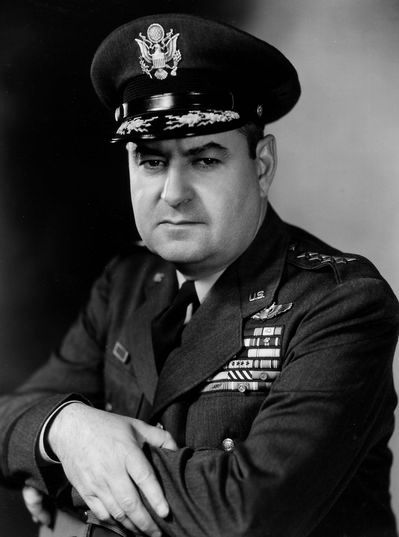In under two decades, U.S. Air Force Gen. Curtis LeMay went from being called a “brute” in Japan for his actions during World War II to being honored by the Japanese government for his post-war efforts.
More than 60 years later, LeMay is back in the news, with a citizens’ activist group calling for revocation of his Japanese medal.
 U.S. Air Force Gen. Curtis LeMay (From the U.S. Air Force website)
U.S. Air Force Gen. Curtis LeMay (From the U.S. Air Force website)
LeMay orchestrated the series of massive indiscriminate bombings of Japanese cities near the end of the war.
The deadliest was the March 10, 1945, firebombing on Tokyo that claimed an estimated more than 100,000 civilian lives.
But LeMay, who was demonized by Japanese media during the war, was awarded a top medal by the Japanese government only 19 years later.
Ironically, the reason was for his role in developing Japan’s postwar Air Self-Defense Force.
DERIDED AS ‘BRUTE’ LEMAY
LeMay was assigned to take charge of the strategic bombing campaign against Japan in January 1945 after he had led bomber missions over German cities.
He initially continued with the high-altitude, daytime precision bombing runs targeting mainly military-related targets, including munitions manufacturing facilities, as his predecessor did.
But he soon realized that these missions were ineffective due in part to the strong jet stream and poor weather conditions over Japanese islands, carrying bombs away from their intended targets.
LeMay switched to indiscriminate low-altitude night bombings by choosing densely populated areas of major cities as targets, causing large numbers of civilian deaths as a consequence.
In justifying the massive firebombings, LeMay told his commanders that no war would be winnable without causing deaths among civilian populations, a former U.S. military member who worked for him wrote in a memoir.
LeMay, the memoir continued, also said that Japanese civilians working at munitions production facilities were part of their country’s war machine.
In the Great Tokyo Air Raid, a fleet of some 300 B-29 Superfortress bombers were deployed for the attack that began in the early hours of March 10, raining down a variety of incendiaries on the Japanese capital.
Under LeMay’s command, his bombers also decimated Osaka, Nagoya and other major cities until Japan surrendered on Aug. 15, 1945.
The overall death toll of civilians from these air raids is estimated at 500,000, including those who perished in the atomic bombings of Hiroshima on Aug. 6 and Nagasaki on Aug. 9.
Robert McNamara, who served under LeMay during the bombing campaign against Japan and later became U.S. secretary of defense during the Vietnam War, said LeMay’s conviction was that a war must be won no matter the cost.
In the 2003 documentary “The Fog of War,” McNamara quoted LeMay as telling his crews following the Tokyo air raid, “If we’d lost the war, we’d all have been prosecuted as war criminals.”
LeMay became a household name among the Japanese population as being the villainous mastermind behind the air raids.
“Brute LeMay, Japanese will not be intimidated by massive bombings” blared the headline of a front-page story on the Tokyo air raid in The Asahi Shimbun’s March 13, 1945, edition.
In the story, the newspaper called the general a “man of abnormal character.”
In a June 7 article, the Asahi, running his mug shot, said LeMay “must be licking his lips and be in a frenzy of ecstasy as Tokyo is in flames.”
HONORED IN MIDST OF VIETNAM WAR
After the war, he rose to chief of staff of the U.S. Air Force, the top position of the military branch.
Maintaining his hard-line approach in the Vietnam War, LeMay also pushed for a sustained strategic bombing campaign against North Vietnam.
His decoration by the Japanese government came when he visited Japan in December 1964, two months before his retirement from the military.
He was presented the Grand Cordon of the Order of the Rising Sun at the ASDF’s Iruma Air Base in Saitama Prefecture on Dec. 7, 1964.
Prime Minister Eisaku Sato’s Cabinet approved honoring LeMay three days earlier.
According to media reports from the time, Minoru Genda, a member of the Upper House, spearheaded efforts to officially recognize his postwar achievement.
Before turning to politics, Genda was a prominent presence in Japan’s armed forces.
As an Imperial Japanese Navy pilot, he helped plan the attack on Pearl Harbor and subsequently became chief of staff of the ASDF.
Senior officials with the then Defense Agency acknowledged LeMay’s contributions in terms of the transfer of radar sites and fighter aircraft to Japan after the U.S. occupation ended in 1952.
The officials defended the government gesture by citing similar examples of praise, such as for Gen. Douglas MacArthur, the supreme commander for the Allied Powers who presided over the occupation forces in Japan, and other U.S. military senior leaders involved in Japanese affairs.
The Japanese media and the Japanese public were largely silent about the matter of honoring LeMay.
But the opposition party raised the subject in the Diet.
On the very day he was decorated, Hiroichi Tsujihara, a member of the Japan Socialist Party, took the floor of the Lower House Budget Committee to question the government’s motives.
“(LeMay) was in charge and directly responsible for air raids against our country,” he said.
Tsujihara also said LeMay also commanded the atomic bombings of Hiroshima and Nagasaki.
“What is the reason for honoring him, although it runs counter to Japanese people’s vehement opposition to nuclear and hydrogen bombs?” he said.
In response, Sato remarked: “The past is the past. It is now natural to leave it behind and recognize his accomplishment in a new situation.”
Junya Koizumi, director-general of the Defense Agency, weighed in with support for Sato.
“It is meant to give credit to a host of remarkable contributions he made in the postwar years to the ASDF,” said Koizumi, father of future Prime Minister Junichiro Koizumi. “This should be separated from the war-related issues.”
The defense chief continued: “LeMay did not have direct oversight for forces dropping the atomic bombs as he was assigned to a new task prior to the atomic bombings.”
LeMay died at the age of 83 in 1990.
CENSORSHIP LESSENED PUBLIC OUTRAGE
Against the backdrop of the government’s controversial award is that in the postwar years, both Tokyo and Washington had tried to gloss over the atrocities committed by the U.S. military against Japanese civilians, according to Nobuo Kamioka, professor of American literature at Gakushuin University.
Kamioka published a biography on LeMay, “Tokyo Daikushu wo Shikishita Otoko Curtis LeMay,” (Curtis LeMay, the man who orchestrated the Great Tokyo Air Raid), in February.
The General Headquarters of the Supreme Commander for the Allied Powers imposed a press code during its seven-year occupation.
Japanese news media were strictly forbidden to print or broadcast reports critical of the U.S. authorities and other allied powers, as well as the U.S. military’s brutalities.
The heavy censorship, as a result, took survivors of the wartime horrors many years to become fully aware of the Japanese government’s responsibility for the destruction and suffering and translate their anger into a crusade calling for state compensation and relief measures.
Hibakusha formed the Japan Confederation of A- and H-Bomb Suffers Organizations as late as in 1956 after the horror of nuclear weapons was thrust into public consciousness anew by the tragedy of the Japanese No. 5 Lucky Dragon tuna boat.
The boat, with 23 fishermen aboard, was exposed to the radioactive fallout from a U.S. hydrogen bomb test conducted at Bikini Atoll in the Pacific in March 1954.
One crew member died of radiation sickness six months later while others were admitted to hospitals to treat symptoms of acute radiation syndrome.
The confederation, known as Nihon Hidankyo, received the 2024 Nobel Peace Prize.
More than a quarter-century after they were victimized, firebomb survivors set up the Japan air raid victim liaison committee to press for state compensation in 1972.
While LeMay directed and implemented the incendiary attacks against Japanese cities, his role in the nuclear attacks was simply to see the bombing forces take off to the targeted cities.
LeMay, however, was condemned in Japan as the mastermind of the atomic bombing rather than the air raids.
It is partly because Japanese at the time did not realize the full extent of the devastation caused by the firebombings.
“In consequence, since the air raids did not spark a huge controversy in Japan, it enabled the U.S. military to launch heavy aerial bombing campaigns in the Korean War and Vietnam War,” Kamioka said.
He said decorating LeMay may have sent the wrong message to the world.
“It could have been taken by the international community that Japan accepted his wartime actions and is grateful,” he said.
But the question of honoring LeMay was revisited recently by a peace advocacy group.
The group, called Gamafuya, submitted to the government a petition calling for revocation of the honor on March 10, the 80th anniversary of the Great Tokyo Air Raid.
“Decorating LeMay by the Japanese government is tantamount to endorsing the massacre of its own people,” said a representative of the group, which is based in Okinawa Prefecture.
An official with the Cabinet Office, which has jurisdiction over laws related to the selection of honorees, replied that the official record cites LeMay’s contributions to the ASDF and nothing else.
“Unless new facts emerge to challenge the basis for the citation, there will be no further debate on the issue,” the official said.


AloJapan.com